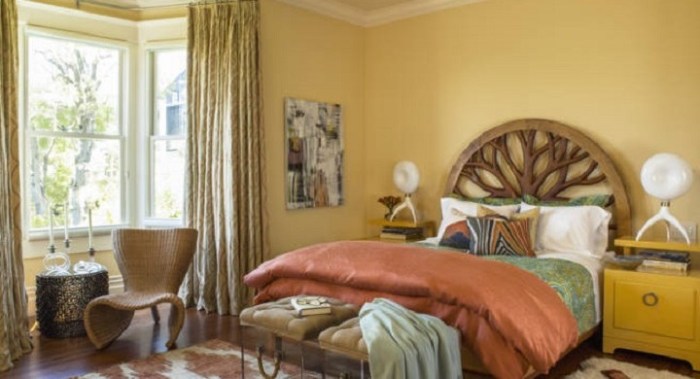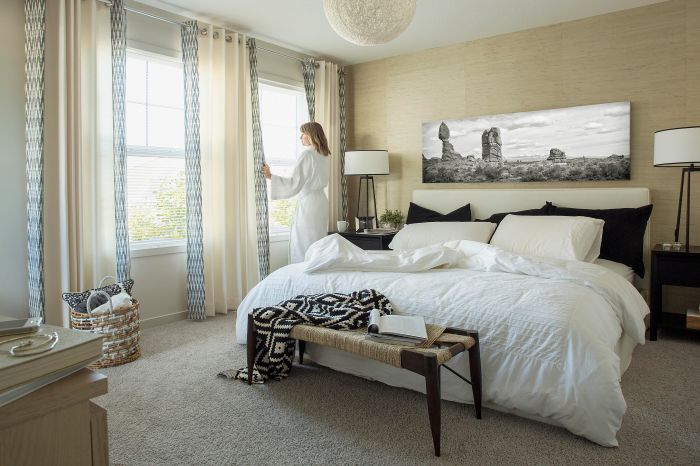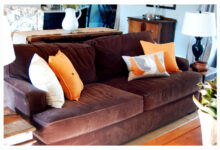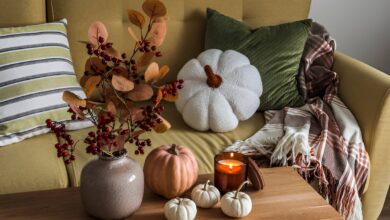Every Bedroom Needs A Cozy Guide
Every Bedroom Needs more than just a bed; it needs a carefully curated atmosphere that fosters relaxation and rejuvenation. This guide explores the essential elements for creating a truly inviting and functional sleep sanctuary, from selecting the perfect furniture and lighting to incorporating personal touches and smart technology. We’ll delve into practical tips for optimizing space, enhancing ambiance, and maximizing comfort to transform your bedroom into a haven of peace and tranquility.
Whether you’re designing a brand new bedroom or simply looking to refresh your existing space, this comprehensive guide will equip you with the knowledge and inspiration to create a bedroom that perfectly reflects your personal style and promotes a restful night’s sleep. We’ll cover everything from choosing the right mattress and bedding to implementing smart home technology and maximizing storage solutions, ensuring your bedroom is not only stylish but also highly functional.
Essential Furniture
Creating a comfortable and functional bedroom relies heavily on selecting the right furniture. The pieces you choose will significantly impact the room’s overall aesthetic and how efficiently you can use the space. This section will explore essential bedroom furniture, focusing on layout considerations, space-saving solutions, bed frame options, and dresser features.
Bedroom Layouts for Different Room Sizes
Effective bedroom layouts vary depending on the room’s dimensions. In a large bedroom, a spacious arrangement might include a king-size bed centrally positioned, flanked by sizable nightstands, with a dresser and perhaps a vanity or seating area positioned along a wall. A smaller bedroom, however, would necessitate a more compact setup. A queen or full-size bed might be placed against a wall, with a narrow nightstand on one side and a smaller dresser or chest of drawers positioned elsewhere in the room.
Consider maximizing vertical space in smaller rooms by using tall, narrow dressers or incorporating built-in storage solutions. In both cases, leaving adequate space for movement around the bed is crucial for comfort and functionality.
Space-Saving Furniture Solutions for Small Bedrooms
Small bedrooms often require creative furniture choices to maximize space. Murphy beds, which fold away into the wall, are a popular solution, freeing up floor space during the day. Loft beds, which elevate the sleeping area, can create space underneath for a desk or additional storage. Using ottomans with built-in storage provides extra space for blankets, pillows, or clothes.
Slim-profile dressers and nightstands, designed with depth in mind, help to avoid overcrowding the room. Multifunctional furniture, such as a storage bench at the foot of the bed or a chest that doubles as a bedside table, can further enhance space efficiency.
Every bedroom needs a comfortable bed and a relaxing atmosphere, but did you know it also needs a contribution to a sustainable future? Thinking about energy efficiency, consider installing solar panels on your roof; check out this guide on solar panels for residential use to learn more. Reducing your carbon footprint contributes to a better environment, something every bedroom – and everyone – benefits from.
Bed Frame Styles and Materials
Several bed frame styles and materials offer various aesthetic and practical benefits. A platform bed, typically made of wood or metal, features a low profile and built-in support slats, eliminating the need for a box spring. This is ideal for smaller bedrooms due to its low profile and often streamlined design. Metal bed frames are durable, easy to clean, and relatively inexpensive, although they can be less aesthetically versatile than wooden frames.
Wooden bed frames, on the other hand, offer a wide range of styles and finishes, from rustic to modern, but they are generally heavier and more expensive. Upholstered bed frames provide a softer, more luxurious look and feel, often incorporating storage within the frame, but they may require more careful cleaning and maintenance.
Essential Dresser Features and Their Importance in Bedroom Organization
A well-designed dresser is vital for efficient bedroom organization. The number of drawers is a key consideration; more drawers offer greater storage capacity, but too many might make the dresser bulky. Drawer size and dividers are also important for optimizing storage. Larger drawers are suitable for bulky items like sweaters, while smaller drawers are ideal for folded clothes or accessories.
Internal dividers help to keep items separated and prevent them from becoming jumbled. Durable construction and smooth-gliding drawers ensure longevity and ease of use. Finally, the dresser’s overall dimensions should be carefully considered in relation to the available space in the bedroom.
Lighting & Ambiance

Source: homeandecoration.com
Creating the perfect bedroom atmosphere relies heavily on thoughtful lighting. It’s more than just illuminating the space; lighting significantly impacts mood, sleep quality, and overall comfort. A well-designed lighting scheme layers different types of light to achieve a versatile and inviting environment.Layered lighting, incorporating ambient, task, and accent lighting, offers superior control and flexibility compared to a single overhead light.
This approach allows you to tailor the lighting to your specific needs and desired mood throughout the day and night. Each layer plays a unique role in achieving a balanced and aesthetically pleasing illumination.
Layered Lighting Explained, Every Bedroom Needs
Ambient lighting provides general illumination for the entire room. Think of it as the foundation of your lighting scheme. This could be a ceiling fixture, recessed lights, or even a softly glowing pendant lamp. It sets the overall tone and brightness level of the room. Task lighting, on the other hand, is focused and provides concentrated light for specific activities.
A bedside lamp for reading, a desk lamp for working, or a vanity light for makeup application are all examples of task lighting. Finally, accent lighting highlights specific features or objects in the room. This could be a strategically placed wall sconce to draw attention to artwork, or a small lamp illuminating a plant or decorative item.
The interplay of these three layers creates depth and visual interest, enhancing the overall ambiance.
Designing a Bedroom Lighting Scheme
For optimal effect, consider a layered lighting scheme incorporating various lamp types and placement strategies. A central ceiling fixture (perhaps a dimmer-controlled flush mount or semi-flush mount) provides ambient lighting. Two bedside table lamps offer task lighting, ideal for reading before sleep. A small, adjustable desk lamp is beneficial for anyone who works from their bedroom. Finally, strategically placed wall sconces or picture lights can act as accent lighting, subtly highlighting artwork or architectural features.
Placement should be carefully considered; bedside lamps should be positioned to avoid glare while reading, and accent lighting should enhance, not overwhelm, the room’s features. Consider the size of the room and the overall style when selecting fixture sizes and styles.
Creating a Calming and Relaxing Ambiance
Achieving a calming and relaxing bedroom ambiance through lighting is all about choosing the right color temperature and intensity. Warm-toned lighting (around 2700K-3000K), often described as soft white or yellowish white, is generally preferred for bedrooms. Avoid harsh, cool-toned white light (above 5000K), as this can be stimulating and disruptive to sleep. Dimmable lights are crucial; lowering the intensity in the evening helps to signal the body that it’s time to wind down.
Consider using soft, indirect lighting, such as floor lamps with fabric shades or table lamps with opaque shades, to create a gentler, less harsh illumination. Avoid bright, direct light sources immediately before bedtime. A Himalayan salt lamp, emitting a soft, warm glow, can contribute to a relaxing atmosphere. Incorporating natural light during the day also plays a vital role in regulating the body’s circadian rhythm.
Benefits of Dimmers and Smart Lighting Controls
Dimmers allow for precise control over lighting intensity, offering flexibility to adjust the ambiance according to the time of day and activity. This gradual dimming helps to create a more soothing and sleep-conducive environment. Smart lighting controls, such as smart bulbs or smart switches, offer even greater control and automation. They can be programmed to adjust lighting levels automatically throughout the day, mimicking the natural light cycle.
This can help to regulate your body’s natural sleep-wake cycle, improving sleep quality. Furthermore, smart lighting allows for remote control, enabling you to adjust lighting even when you’re not in the room. This is particularly useful if you want to set the mood for relaxation before entering your bedroom.
Every bedroom needs a comfortable bed and good lighting, of course. But access to reliable electricity is crucial for comfort and safety, and that’s where initiatives like Solar power expansion in Africa become incredibly important. This expansion brings electricity to areas previously lacking it, ultimately improving the quality of life and ensuring even bedrooms in remote areas can have the power they need.
Textiles & Decor: Every Bedroom Needs
Choosing the right textiles and decor is crucial for transforming your bedroom from a simple sleeping space into a comfortable and stylish sanctuary. The textures, patterns, and colors you select significantly impact the overall mood and atmosphere of the room, influencing everything from your sleep quality to your daily mood. Careful consideration of these elements can create a haven that truly reflects your personal style and promotes relaxation.
Essential Textiles and Their Impact
The foundation of a comfortable and aesthetically pleasing bedroom lies in the selection of key textiles. These elements not only contribute to the visual appeal but also directly affect the tactile experience and overall comfort level. A well-chosen combination of bedding, curtains, and rugs can elevate the entire space.
- Bedding: Sheets, duvet covers, and blankets are fundamental. High-thread-count cotton sheets offer luxurious softness and breathability, promoting restful sleep. A plush duvet provides warmth and comfort, while a textured throw blanket adds a layer of visual interest and coziness. Consider the season when selecting bedding; lighter materials are ideal for warmer months, while heavier fabrics are better suited for colder weather.
- Curtains: Curtains control light and privacy, but also contribute significantly to the room’s style. They can soften harsh light, add warmth, and enhance the overall aesthetic. The choice of fabric influences the level of light filtering and insulation.
- Rugs: Rugs define areas within the bedroom, add warmth underfoot, and introduce texture and color. A large rug placed under the bed can ground the space and create a sense of luxury, while smaller rugs can be used to define seating areas or add pops of color.
Textile Textures and Patterns for Different Moods
The texture and pattern of your textiles are powerful tools for setting the mood in your bedroom. Different textures evoke different sensations, while patterns can add visual interest and personality.
- Relaxing Mood: Soft, plush textures like velvet, faux fur, or cashmere create a sense of calm and indulgence. Subtle, muted patterns like stripes or small florals can enhance this peaceful atmosphere. Think soft greys, muted blues, or creamy whites.
- Energetic Mood: Crisp linen or cotton with bold geometric patterns or vibrant colors can energize the space. Think bright yellows, oranges, or even a playful mix of patterns. A textured jute rug could also add to this dynamic feel.
- Romantic Mood: Flowing silks, satins, or lace add a touch of elegance and romance. Delicate floral patterns, soft pastels, and luxurious textures contribute to a dreamy atmosphere.
Choosing Appropriate Curtain Fabrics for Light Control and Privacy
Curtain fabric selection is key to controlling light and maintaining privacy. Heavier fabrics like velvet or blackout curtains offer superior light blocking and insulation, ideal for light sleepers or those who prefer a dark room. Sheer fabrics, on the other hand, allow natural light to filter through while still offering a degree of privacy. Linen and cotton are versatile options offering a balance of light control and breathability.
Consider the level of light control and privacy needed when choosing your curtain fabric.
A Serene Blue and White Bedroom
Imagine a bedroom designed around a calming blue and white color palette. The walls are painted a soft, calming shade of sky blue, complemented by crisp white bedding and sheer white curtains that allow gentle sunlight to filter through. A plush, light blue rug sits under the bed, adding warmth and texture. White furniture with subtle blue accents creates a sense of airy spaciousness.
This combination evokes a feeling of serenity, peace, and tranquility, creating a perfect haven for relaxation and restful sleep. The overall mood is calming and peaceful, ideal for promoting a sense of well-being.
Storage & Organization
A well-organized bedroom is crucial for creating a peaceful and restful environment. Effective storage solutions not only maximize space but also contribute significantly to a sense of calm and order, directly impacting your sleep quality and overall well-being. Let’s explore practical strategies to optimize your bedroom storage.
Innovative Storage Solutions for Small Bedrooms
Small bedrooms often present a significant storage challenge. However, with creative thinking and the right furniture choices, you can maximize space and maintain a clutter-free environment. Utilizing vertical space and hidden storage options are key.
- Under-bed storage: Utilize the often-unused space under your bed with rolling storage containers or drawers. These can store seasonal clothing, bedding, or other items you don’t need daily access to. Consider clear containers for easy identification of contents.
- Vertical shelving: Maximize vertical space with tall, narrow bookshelves or floating shelves. These can hold books, decorative items, and even folded clothes, freeing up valuable floor space. Consider using shelves that extend to the ceiling to maximize capacity.
- Over-the-door organizers: These handy organizers hang on the back of your bedroom door and provide extra storage for shoes, accessories, or toiletries. Choose organizers with multiple pockets or compartments for better organization.
- Wall-mounted storage: Install wall-mounted shelves or cabinets to create additional storage without taking up floor space. This is particularly useful for smaller items like jewelry, cosmetics, or books.
Effective Closet Organization
A well-organized closet is essential for a streamlined bedroom. Using various storage containers and dividers can transform a chaotic space into an efficient and aesthetically pleasing area.
Begin by decluttering your closet. Remove anything you no longer wear, need, or use. Then, consider these organizational strategies:
- Shelf dividers: These prevent clothes from toppling over and create neat, organized stacks. They are especially useful for folded items like sweaters and t-shirts.
- Hanging organizers: These fabric or plastic organizers hang from the closet rod and create additional shelving or compartments for folded items or accessories.
- Drawer dividers: These keep drawers organized and prevent clothes from becoming jumbled. They are available in various materials and designs to suit different drawer sizes and contents.
- Vacuum-sealed storage bags: These are ideal for storing bulky items like blankets, comforters, or out-of-season clothing, significantly reducing storage space.
Comparison of Bedroom Storage Furniture
Wardrobes, chests of drawers, and armoires each offer distinct storage solutions, catering to different needs and space constraints.
| Furniture Type | Advantages | Disadvantages |
|---|---|---|
| Wardrobe | Large storage capacity, often includes shelves and drawers, can be freestanding or built-in. | Can be bulky, may require significant floor space. |
| Chest of Drawers | Versatile, compact, suitable for various items like clothes, linens, and accessories. | Limited hanging space, may not be suitable for long garments. |
| Armoire | Stylish, often includes both hanging and shelving space, can serve as a focal point in the room. | Can be expensive, typically large and requires ample floor space. |
Benefits of a Well-Organized Bedroom and Impact on Sleep Quality
A clutter-free and organized bedroom promotes a sense of calm and tranquility, which is essential for quality sleep. A visually uncluttered space reduces mental stimulation and allows for better relaxation before bedtime. The act of organizing itself can be therapeutic and reduce stress levels, leading to improved sleep. Studies have shown a correlation between a tidy living environment and improved mental well-being, positively impacting sleep patterns.
For example, a study published in
Current Biology* linked tidiness with improved mood and reduced stress, suggesting a direct link to better sleep.
Every bedroom needs a comfortable bed and calming atmosphere, of course. But thinking about the bigger picture, a sustainable future is also crucial, and that involves clean energy sources. To learn more about one promising option, check out this article on The future of hydrogen fuel as a green energy source ; understanding green energy helps us build a better future, even impacting the kind of home we create for ourselves.
Ultimately, every bedroom needs to be part of a sustainable world.
Personal Touches & Comfort
Creating a truly restful and rejuvenating bedroom goes beyond just the essentials. It’s about infusing your personality and ensuring a space that fosters relaxation and promotes a good night’s sleep. This involves thoughtful choices in personalizing your space, selecting comfortable materials, and creating a calming atmosphere.Personalizing your bedroom allows you to express your unique style and create a haven that reflects your individual preferences.
This transformation can significantly impact your overall well-being and create a space where you feel truly at home.
Incorporating Personal Collections and Artwork
Adding personal touches transforms a bedroom from a functional space into a reflection of your personality. Displaying cherished items, such as family photos, travel souvenirs, or collections of vintage postcards, adds character and warmth. Artwork, whether paintings, prints, or even framed fabric swatches, can create a focal point and enhance the room’s aesthetic. Consider the overall style of your bedroom when selecting items; a cohesive arrangement creates a more polished and inviting atmosphere.
For instance, a collection of vintage cameras might complement a mid-century modern design, while vibrant textile art could brighten a bohemian-style room. Think about arranging these items in a visually appealing manner, perhaps using shelves, gallery walls, or even repurposed furniture to display your treasures.
Creating a Comfortable and Inviting Atmosphere Through Textures and Colors
The use of textures and colors significantly impacts the feel of a bedroom. Soft, plush textiles like velvet, faux fur, or chunky knit throws contribute to a cozy atmosphere. Natural materials like linen and cotton offer a more relaxed and airy feel. Color plays a crucial role; calming hues like soft blues, greens, and grays promote relaxation, while warmer tones such as creams and muted yellows can create a sense of warmth and comfort.
However, personal preference is key; if you thrive in a vibrant environment, bolder colors can work well, provided they are balanced with calming elements. For example, a rich teal accent wall paired with soft white bedding and natural wood furniture can create a balanced and inviting space. The interplay of textures and colors is what truly defines the atmosphere of your bedroom.
The Importance of a Comfortable Mattress and Pillows for Quality Sleep
Investing in a high-quality mattress and pillows is crucial for ensuring quality sleep. A supportive mattress that aligns your spine properly prevents aches and pains, contributing to restful sleep. The type of mattress – memory foam, innerspring, latex – is a matter of personal preference and body type. Pillows should provide adequate support for your head and neck; consider experimenting with different fill materials (down, feather, memory foam) and pillow heights to find what works best for you.
Regularly replacing your mattress and pillows (generally every 7-10 years for mattresses and every 1-2 years for pillows) is also essential to maintain hygiene and support. A comfortable sleep environment directly translates to improved mood, energy levels, and overall health.
Every bedroom needs a comfortable bed and calming atmosphere, but also sustainable choices. Think about energy efficiency – even small changes make a difference. For instance, understanding how the shift to green energy impacts our economy, as explained in this article How green energy is driving economic growth , can inform your choices about energy-efficient bedding and lighting.
Ultimately, every bedroom needs to reflect a balance of comfort and environmental consciousness.
Technology & Practicality

Source: tqn.com
Integrating technology into your bedroom can enhance comfort, convenience, and even promote better sleep. However, it’s crucial to consider both the advantages and potential downsides before embracing a fully automated sleep sanctuary. A well-planned approach ensures technology complements your space, rather than dominating it.Smart Home Bedroom Setup: A smart home bedroom can be tailored to individual needs and preferences.
A basic setup might include smart lighting, capable of adjusting color temperature and brightness throughout the day to mimic natural sunlight and aid in sleep regulation; smart speakers for hands-free control of music, alarms, and other smart devices; and potentially smart blinds for light control and privacy. More advanced setups could incorporate smart thermostats for climate control, smart security systems, and even smart mattresses that track sleep patterns.
Smart Home Device Integration
Seamless integration requires careful consideration of device placement and aesthetics. Smart speakers, for instance, can be discreetly placed on a nightstand or integrated into a bookshelf. Smart lighting can be incorporated using smart bulbs within existing fixtures or by installing dedicated smart lighting systems that are aesthetically pleasing. A centralized control hub, such as a tablet or a dedicated smart home control panel, can streamline management of all connected devices, reducing clutter and maintaining a clean, organized feel.
Consider using wireless charging pads for smartphones and other devices to minimize visible cords and enhance the overall appearance.
Benefits and Drawbacks of Bedroom Technology
Using technology in the bedroom offers several advantages, including enhanced convenience (controlling lights and temperature remotely), improved sleep quality (through smart lighting and sleep tracking), and increased entertainment options (streaming music and podcasts). However, excessive screen time before bed can disrupt sleep patterns, and the constant connectivity offered by smart devices can be distracting and reduce relaxation. Over-reliance on technology can also create a sense of detachment from the physical environment.
Furthermore, the constant data collection by smart devices raises privacy concerns.
Privacy Concerns and Mitigation Strategies
Smart devices collect data, raising privacy concerns. Data collected might include sleep patterns, listening habits, and even conversations. To mitigate these risks, users should carefully review the privacy policies of all connected devices, opt out of unnecessary data collection features whenever possible, and utilize strong, unique passwords for each device. Consider using privacy-focused smart home hubs that prioritize user data protection, and regularly update firmware to patch security vulnerabilities.
Physical security measures, such as disabling microphone and camera access when not needed, can also provide additional protection.
Closing Notes
Creating the perfect bedroom is a journey of personal expression and thoughtful design. By carefully considering the elements discussed – from furniture and lighting to textiles and technology – you can transform your bedroom into a sanctuary that reflects your unique style and promotes restful sleep. Remember, the key is to prioritize comfort, functionality, and personal touches to create a space where you can truly relax, recharge, and enjoy a peaceful retreat at the end of each day.
Embrace the process, experiment with different ideas, and most importantly, create a space you love.
Query Resolution
What’s the best way to choose a mattress?
Consider your sleep style (side, back, stomach), weight, and any allergies. Try out different mattresses in a store to find the level of firmness that best suits you. Read reviews and compare prices before purchasing.
How can I improve bedroom acoustics?
Rugs, curtains, and upholstered furniture can help absorb sound and reduce echoes. Consider adding soundproofing materials if noise is a significant issue.
What are some affordable ways to add personality to my bedroom?
Use thrifted or repurposed items, create DIY artwork, or display personal collections. Adding plants, unique lighting, or textured throws can also make a big difference.
How often should I wash my bedding?
Ideally, wash your sheets once a week to maintain hygiene and prevent dust mite buildup. Wash pillowcases even more frequently.
How can I maximize storage in a small bedroom?
Utilize vertical space with tall shelves or storage towers. Invest in under-bed storage containers and utilize the space inside your closet efficiently with organizers and shelves.









